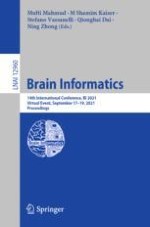This book constitutes the refereed proceedings of the 14th International Conference on Brain Informatics, BI 2021, held in September 2021. The conference was held virtually due to the COVID-19 pandemic.
The 49 full and 2 short papers together with 18 abstract papers were carefully reviewed and selected from 90 submissions. The papers are organized in the following topical sections: cognitive and computational foundations of brain science; investigations of human information processing systems; brain big data analytics, curation and management; informatics paradigms for brain and mental health research; and brain-machine intelligence and brain-inspired computing.
